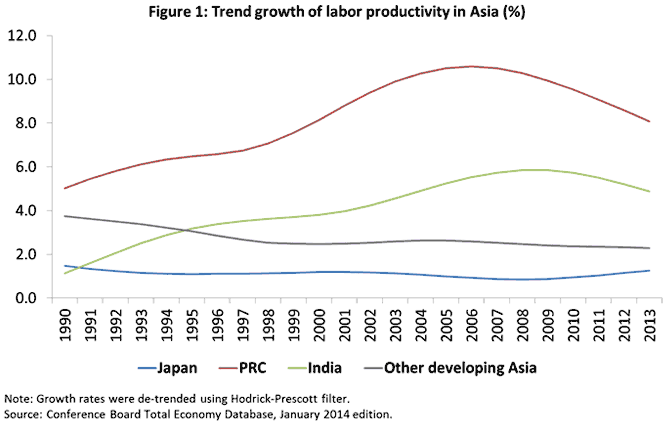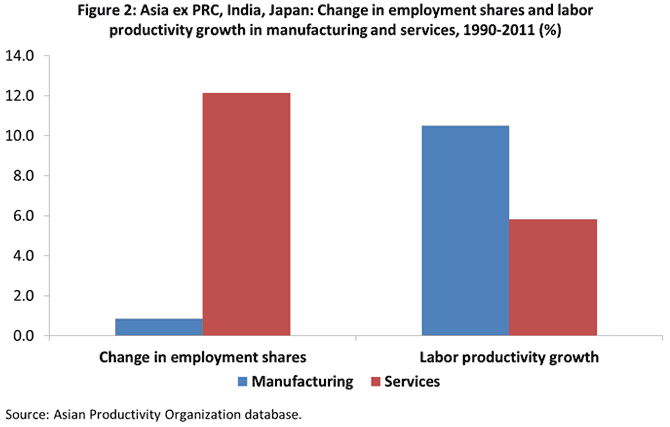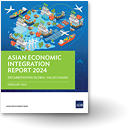Declining growth of output per worker in Asia: so what and what now?
Since the early 2000s, labor productivity growth, or the growth of output per worker (measured by GDP divided by employment), has been declining in most economies in Asia (Figure 1). This means that economic growth in these economies may also fall, along with the growth of workers’ incomes and standards of living. This is more pronounced if high-growth economies in the region such as the People’s Republic of China (PRC), India, and Japan, are excluded. Reducing the number of poor people typically requires a satisfactory rate of growth of the economic pie and has to be accompanied by rising incomes. So falling productivity may also jeopardize the efforts of governments to reduce poverty.

Why is this fall in productivity happening? One major reason is the effect of the recent global crisis that started in advanced economies. As these economies experienced crises they bought fewer goods from Asia, in turn hurting Asia’s exports. Many firms reduced labor requirements as orders became fewer. Another and more important reason is that much of the movement of labor has been towards low-productivity service sectors. Economies grow faster when labor shifts from low- to high-productivity industries. For instance, since World War II, the Republic of Korea, Japan, PRC, and to a lesser extent Malaysia and Thailand, have been able to industrialize as labor shifted from agriculture to higher-productivity manufacturing. The latter has been an engine of growth in these economies, supported by high savings and investment rates and an export-oriented policy. As economies grow, their service sectors also expand, and we see labor moving from manufacturing to services. This can be good or harmful to growth if service sector productivity is higher or lower than the industrial sectors. High productivity services include communications, finance, computer, or business services, while low productivity sectors consist of retail and community or personal services. Labor has apparently shifted to lower-productivity services sectors for many economies in the region (Figure 2).

What should be done to boost productivity? Governments can usually devise policies and allocate budgets to address economic problems. One popular option is to lower their taxes on imported goods to encourage more competition in the economy; this supposedly forces firms to be more efficient in production while allowing consumers to have more choices and better purchases. More open economies tend to do better than those that limit trade and investment across borders. Another is to lower the cost of transport by investing in infrastructure such as roads, bridges, ports, and telecommunications. Economies that have well-developed infrastructure also tend to have higher productivity and growth. Productivity also depends on firms’ innovative efforts, and governments can also improve investments in education, research and development as well as create conditions for better diffusion of knowledge to enhance an economy’s productivity. Development and policy-making are a complex process, and it is also important for governments to devise policies that are politically feasible.
Since the early 2000s, labor productivity growth, or the growth of output per worker (measured by GDP divided by employment), has been declining in most economies in Asia (Figure 1). This means that economic growth in these economies may also fall, along with the growth of workers’ incomes and standards of living. This is more pronounced if high-growth economies in the region such as the People’s Republic of China (PRC), India, and Japan, are excluded. Reducing the number of poor people typically requires a satisfactory rate of growth of the economic pie and has to be accompanied by rising incomes. So falling productivity may also jeopardize the efforts of governments to reduce poverty.

Why is this fall in productivity happening? One major reason is the effect of the recent global crisis that started in advanced economies. As these economies experienced crises they bought fewer goods from Asia, in turn hurting Asia’s exports. Many firms reduced labor requirements as orders became fewer. Another and more important reason is that much of the movement of labor has been towards low-productivity service sectors. Economies grow faster when labor shifts from low- to high-productivity industries. For instance, since World War II, the Republic of Korea, Japan, PRC, and to a lesser extent Malaysia and Thailand, have been able to industrialize as labor shifted from agriculture to higher-productivity manufacturing. The latter has been an engine of growth in these economies, supported by high savings and investment rates and an export-oriented policy. As economies grow, their service sectors also expand, and we see labor moving from manufacturing to services. This can be good or harmful to growth if service sector productivity is higher or lower than the industrial sectors. High productivity services include communications, finance, computer, or business services, while low productivity sectors consist of retail and community or personal services. Labor has apparently shifted to lower-productivity services sectors for many economies in the region (Figure 2).

What should be done to boost productivity? Governments can usually devise policies and allocate budgets to address economic problems. One popular option is to lower their taxes on imported goods to encourage more competition in the economy; this supposedly forces firms to be more efficient in production while allowing consumers to have more choices and better purchases. More open economies tend to do better than those that limit trade and investment across borders. Another is to lower the cost of transport by investing in infrastructure such as roads, bridges, ports, and telecommunications. Economies that have well-developed infrastructure also tend to have higher productivity and growth. Productivity also depends on firms’ innovative efforts, and governments can also improve investments in education, research and development as well as create conditions for better diffusion of knowledge to enhance an economy’s productivity. Development and policy-making are a complex process, and it is also important for governments to devise policies that are politically feasible.
*




